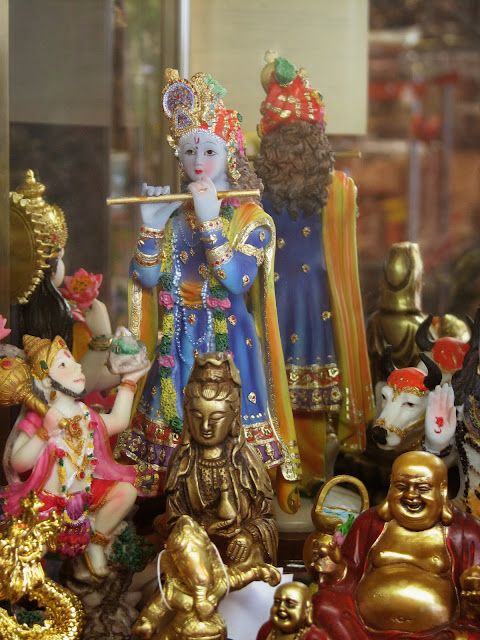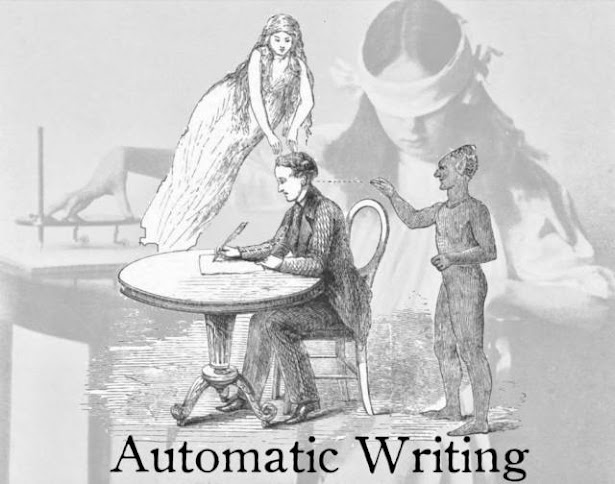KRISHNA NOT A VIRGIN BORN CRUCIFIED SAVIOR!
Subject: The Claim that Krishna was a Virgin Born, Crucified Savior is a 19th century Western invention that continues to be circulated by ignorant, intellectually lazy people who've never bothered to read the classic Hindu texts on the subject, most of which are now readily available in English. See further Jesus & Krishna: Two Different Versions of the Same Archetypal Myth?, and Krishna, Not Virgin Born, Not Born on December 25. If the subject of other alleged "crucified saviors" is of interest I would invite my readers to read my posts on Was Prometheus a Crucified Saviour on the Pattern of Many Other Gods Including Jesus. Then further The Buddha: Virgin Born? Dying & Rising God? On the late Christopher Hitchens's plagiarism in his own discussion of "crucified saviours" see An Example of Christopher Hitchens’s Plagiarism . On a related topic, see Does Christian Apologist Ravi Zacharias and/or Multnomah Books Know the Difference Between Krishna and Shiva? Or Between the Mahabharata and the Ramayana?
Let's begin:
Let's begin:
Key Classical Indian Sources for the Stories of Krishna’s Life: Mahabharata (= M, c. 300 BC-c. 300 AD), Harivamsha (c. 450 AD), Vishnu Purana (= VP c. 400-500 AD), Bhagavata Purana (= BP, c. 950 AD).[1] The most influential telling is the last mentioned one, the BP.
Common False Claims: (1) Krishna was born of the virgin Devaki / Devaka /Yasoda, (2) on December 25th and was (3) crucified (4) between two thieves, (5) for our sins, [2] (6) rose from the dead and ascended into heaven. (7) That he was born/died c. 1200 BC.
Now, let us give the correct story for each of these seven false claims in turn:
(1) Krishna was the 8th son of Vasudeva and Devaki. The name of their first son was Kirtiman.[3] The BP credits the pregnancy to “mental transmission”[4] through the mind of Vasudeva into the womb of Devaki. That detail is from a late source (c. 950 AD), does not really represent a virgin birth, since Devaki was not a virgin, and is not present in the earlier accounts of Krishna’s birth in the H (c. 450 AD) and VP (c. 400-500 AD). The names Devaka (used by Christopher Hitchen’s and the source he plagiarized [5]) and Yasoda, used by Kersey Graves[6]) are errors deriving from a basic ignorance of the story.
(1) Krishna was the 8th son of Vasudeva and Devaki. The name of their first son was Kirtiman.[3] The BP credits the pregnancy to “mental transmission”[4] through the mind of Vasudeva into the womb of Devaki. That detail is from a late source (c. 950 AD), does not really represent a virgin birth, since Devaki was not a virgin, and is not present in the earlier accounts of Krishna’s birth in the H (c. 450 AD) and VP (c. 400-500 AD). The names Devaka (used by Christopher Hitchen’s and the source he plagiarized [5]) and Yasoda, used by Kersey Graves[6]) are errors deriving from a basic ignorance of the story.
(2) The celebration of Krishna’s birthday is one of the most prominent festivals in India, which takes place in the late summer or early fall (Bhadra in the North of India, Shravana in the South).[7] The idea that that his birthday was celebrated on December 25 derives from no other source than the ignorant and/or dishonest English-speaking “Freethinkers” who falsely claimed that Shravana “answers to our December.”[8]
(3) Krishna was not crucified. He died when the hunter Jara shot him in the sole of his foot. In most stories it was said to be an accident,[9] in one, that Jara was actually a demon getting revenge for being killed by Krishna in a previous life.[10] The reason Krishna died the way he did was that, with the exception of the soles of his feet, his body was invincible due to a boon granted him by the sage Durvāsas[11]
(4) Crucified between two thieves: nothing like that at all in the authentic Hindu sources.
(5) Krishna died not for our sins but in fulfillment of two curses made against him and his clan: (i) The curse of the widow Gandhari, for not stopping the battle in which her husband Dhritarashtra died,[12] and (ii) The curse of the Brahmanas, for a stunt Krishna’s son, Samba, played on some holy men.[13] (6) Krishna’s spirit does ascend, but his body remains and is cremated[14] (6) The date 1200 BC as the time of Krishna’s birth/death, in not correct.[15] Traditionally Krishna’s death took place just around 3100 BC marking the beginning of the Age of Kali.[16]
PICTURES FALSELY PUT FORWARD AS REPRESENTING KRISHNA CRUCIFIED KRISHNA
Example I: The above image, often erroneously said to represent the crucified Krishna, is actually a bronze Irish crucifix reported on in the 19th century, of a sort that is extremely common, not only in Ireland but also throughout Europe. Below is a similar one from France dated to the 13th century and currently in the Nelson-Atkins Museum in Kansas City, MO (right).[17]
Example II: The above picture, though often claimed to represent Krishna crucified, is actually a drawing of the 12thcentury AD Celtic Market Cross at Tuam, Country Galway, Ireland, portraying Jesus crucified. Below is an old photograph of it, with a detail revealing its proximity to the Ulster Bank.[18]
It still exists, but was moved in 1992 from the square to St. Mary’s Cathedral in the same city.[19]
Notes
1. I am following the dates given in Wendy Doniger, The Hindus: An Alternative History (New York: Penguin Press, 2009).
2. Kersey Graves, The Worlds Sixteen Crucified Saviors (4th ed. rev. and enl.; Boston: Colby and Rich, 1876), 140.
3. BP 10.1.56-57, p. 13.
4. BP 10.2.17, 10.2.16-18,
5. Christopher Hitchens, god is not Great: How Religion Poisons Everything (New York, Boston: Twelve, 2007), 23. Hitchens source is an atheist book published in the 1930s, entitled Essays on Freethinking, by Chapman Cohen (1868-1954). Hitchens actually reprints the portion he plagiarized in the collection The Portable Atheist (2007).
6. Kersey Graves, Sixteen Crucified Saviors, 50, Graves simply gets the characters mixed up.
7. See, e.g., “Krishna Jayanti: Birthday of the God of Divine Love,” Hinduism Today (April, May, June 2010): 30; John Stratton Hawley, At Play with Krishna: Pilgrimage Dramas from Bridavan (with Shrivatsa Goswami; Dehli: Motilal Banarsidass, 1992 [orig. ed. Princeton University Press, 1981]): 62.
8. Graves, Sixteen Crucified Saviors, 69.
9. M 16:4 (Mausala-parva, “Book of the Clubs”); VP 5:37, and in the BP 11.30.27-40.
10 Vettam Mani, Purāṇic Encyclopedia (Dehli: Motilal Banarsidass, 1975), 429.
11. M 13:159 (Anusasana parva “Book of Instructions”), M 16:4 (Mausala-parvan, “Book of the Clubs”).
12. M 11:25 (Sitrī-parva “Book of the Women”).
13. M 16:3 (Mausala-parva, “Book of the Clubs”); VP, 5:37; BP 11.5.2-23 & 11.30.33.
14. M 1:2 (Adi-parva, “Book of the Beginning”); M 16:7, (Mausala-parva, “Book of the Clubs”); VP 5.38; BP 11.30.2.
15. The claim appears, e.g., in Graves, Sixteen Crucified Saviors, 65. It was, however, at one time thought to be correct: See, e.g., James Tod, “On the Religious Establishments of Méwar,” Transactions of the Royal Asiatic Society of Great Britain and Ireland 2.1 (1829): 299.
16. “Kali Yuga,” in Roshen Dalal, Hinduism: An Alphabetical Guide (New Delhi: Penguin Books India, 2010), 187.
17. For several other examples, see http://huntmuseum.com/collection.aspx and then select from the menus as follows: All Object Types: “Religious/Ritual Equipment,” All Materials: “Metal” Key word in Title: “Corpus,” Key word in Description: “Crucifix Figure.” Or if you would prefer to go directly to the crucifixes most similar to the one claimed as Krishna here, simply enter in the Registration Number for each as follows: CG064, CG 066, CG 068, HCM 040, HCM 046, HCM 047.
18. T. H. Mason’s photo reproduced from Arthur Kingsley Porter, The Crosses and Culture of Ireland (New Haven, CN: Yale University Press / London: Oxford University Press, 1931), Pl. 194.
19. See further, Maggie McEnchroe Williams, “Constructing the Market Cross at Tuam: The Role of Cultural Patriotism in the Study of Irish High Crosses,” in From Ireland Coming: Irish Art from the Early Christian to the Late Gothic Period and Its European Context (ed. Colum Hourihane; Princeton, NJ: Princeton University Press, 2001), 141-60.










Comments
Post a Comment